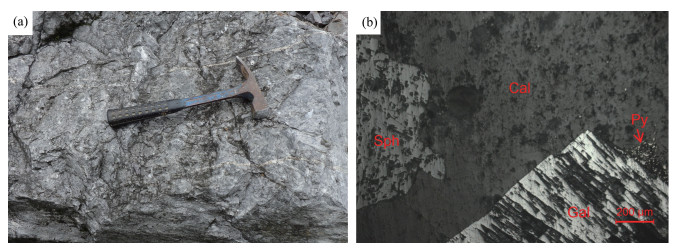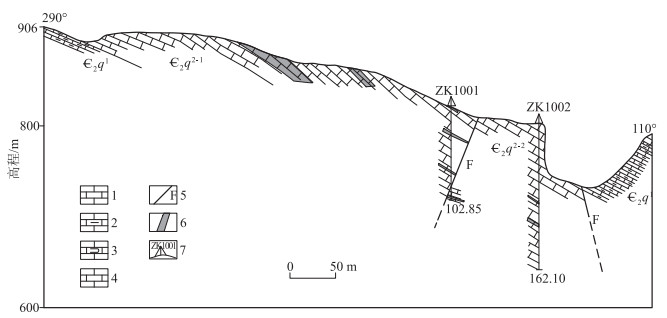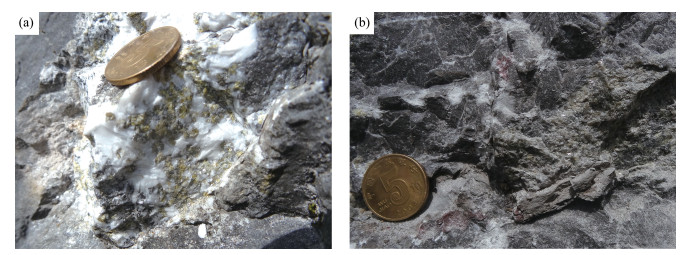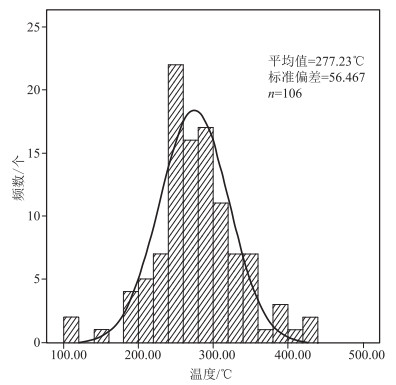Rb-Sr Isotope ages and fluid inclusion characteristics of Pb-Zn deposit and their prospecting significance in Panshi-Panxin region, eastern Guizhou Province
-
摘要:
黔东盘石—盘信地区铅锌矿床位于雪峰山西缘,扬子地块与江南造山带的结合部位,是黔东地区比较典型的铅锌矿床。对该区铅锌矿床成矿期闪锌矿进行Rb-Sr等时线法定年,获得成矿年龄为486±3 Ma(MSWD=1.2),(87Sr/86Sr)i值为0.70918±0.00002。成矿期方解石的流体包裹体岩相学、显微测温及成分分析表明,该区流体包裹体以富液的气液两相包裹体为主,均一温度为277℃,包裹体气相成分以CO2、H2O为主,个别还含有少量CH4,液相成分以Na+、Ca2+、Mg2+、Cl-为主,少量K+、SO42-。综合研究表明:本区矿床形成于晚寒武世末—早奥陶世初,晚于赋矿地层寒武系第二统清虚洞组,属于后生成矿。闪锌矿(87Sr/86Sr)i值高于赋矿围岩,与早寒武世海水的87Sr/86Sr值相近,结合区域地层含矿性分析,推测成矿物质可能来源于下伏寒武系牛蹄塘组黑色岩系;成矿流体为中低温热卤水成因,可能还混有其他热液来源,Pb、Zn元素在成矿流体中以氯化物形式迁移的可能性较大。
-
关键词:
- Rb-Sr等时线年龄 /
- 流体包裹体 /
- 铅锌矿床 /
- 盘石—盘信地区 /
- 贵州
Abstract:The Pb-Zn deposit in Panshi-Panxin area, located on the Western margin of Xuefeng Mountain and the junction of Yangtze block and Jiangnan orogenic belt, is relatively a typical one in Songtao area, East Guizhou.The Rb-Sr isochronal dating on sphalerite of main metallogenic period yields an age of 486±3 Ma(MSWD=1.2) and (87Sr/86Sr)i=0.70918±0.00002.The results of petrography, microthermometer and composition analysis on fluid inclusion in calcite show that the liquid-rich liquid-vapor-type fluid inclusions are the primary ones with a homogenization temperature of 277.23℃, and vapor phases are dominated by CO2 and H2O, with minor CH4 present in individual fluid inclusion, and the ionic compositions are dominated by Na+, Ca2+, Mg2+, Cl- and minor K+and SO42-.The comprehensive studies show that the Pb-Zn deposit of this area was formed in the Late Cambrian to Early Ordovician, later than the country rock of Cambrian Second Series Qingxudong Formation, and indicate a genesis of epigenetic deposit.The(87Sr/86Sr)i of sphalerite is higher than the wall rock, similar to the 87Sr/86Sr ratio of Early Cambrian seawater.Based on the analysis of the ore-bearing potential of the regional strata, it is speculated that the metallogenic material is derived from the Cambrian Niutitang Formation black shale series.The ore-forming fluid is of medium and low temperature hot brine origin and may be mixed with other hydrothermal sources.It is more likely that Pb and Zn migrated in the ore-forming fluid in the form of chloride.
-
Keywords:
- Rb-Sr isotope age /
- fluid inclusion /
- Pb-Zn deposits /
- Panshi-Panxin region /
- Guizhou Province
-
致谢: 在野外调查、资料收集及整理过程中,贵州省地矿局103地质大队潘文总工程师、蒋天锐研究员、袁良军研究员、左勇硕士、杨俊华助理工程师、雷永昌高级工程师及田莉萍高级工程师,中国地质大学(武汉)张国印硕士等给予了大力帮助;在实验测试中,中国地质大学(武汉)流体地质学实验室、武汉地质调查中心实验室的相关老师付出了辛勤劳动;在论文撰写及成稿过程中,中国地质大学(武汉)孙华山老师提出了许多宝贵意见及建议,对本文全程指导;此外还得到中国地质大学(武汉)姚书振、丁振举和皮道会老师的帮助,在此一并感谢。
-
图 1 黔东盘石—盘信地区地质简图(据参考文献[3]修改)
S—志留系;O—奥陶系;∈3-4—寒武系第三统-芙蓉统;∈1-2—寒武系纽芬兰统-第二统;Z—震旦系;Qbbx—青白口系板溪群;1—背斜轴;2—铅锌矿点;3—取样位置;4—研究区
Figure 1. Simplified geological map of the Panshi-Panxin region, Eastern Guizhou
表 1 盘石—盘信地区铅锌矿床闪锌矿Rb、Sr同位素分析结果
Table 1 Rb-Sr dating data of sphalerites from the Panshi-Panxin Pb-Zn deposit
样号 样品名称 Rb/10-6 Sr/10-6 87Rb/86Sr 87Sr/86Sr(1σ) PS-1 闪锌矿 0.1157 1.416 0.2357 0.71079±0.00003 PS-2 闪锌矿 0.1677 0.8443 0.573 0.71318±0.00004 PS-3 闪锌矿 0.1284 1.074 0.345 0.71159±0.00002 PS-4 闪锌矿 0.0881 0.4607 0.5516 0.71300±0.00004 PS-5 闪锌矿 0.1681 0.6278 0.7725 0.71451±0.00005 PS-7 闪锌矿 0.09389 0.643 0.4211 0.71211±0.00002 PS-13 闪锌矿 0.1381 1.399 0.2846 0.71114±0.00002 表 2 盘石—盘信地区铅锌矿床方解石的流体包裹体岩相学特征及均一温度
Table 2 Petrographic characteristics and homogenization temperature of fluid inclusions calcite from the Panshi and Panxin Pb-Zn deposit
样号 取样位置 层位 包裹体类型 包裹体形态 大小
/μm测温
个数气液比
/%均一温度/℃ LT-1 盘石嗅脑 ∈2q2-2 气液包裹体 近椭圆-椭圆形 4~10 16 5~20 304.53 LT-2 盘石嗅脑 ∈2q2-2 气液包裹体 近椭圆-近方形 4~8 18 5~15 267.56 LT-3 盘信团塘 ∈2q2-2 气液包裹体 近椭圆-近方形 4~8 16 3~15 280.92 LT-4 盘信团塘 ∈2q2-2 气液包裹体 近椭圆-近方形 3~6 14 5~10 260.29 LT-6 盘信团塘 ∈2q2-2 气液包裹体 近椭圆-长条形 4~10 16 5~20 246.13 LT-7 盘信团塘 ∈2q2-2 气液包裹体 近方形 3~4 10 5~20 276.80 LT-8 盘信老屋场 ∈2q2-2 气液包裹体 近椭圆-长条形 2~6 10 5~20 255.20 LT-15 盘石嗅脑 ∈2q2-2 气液包裹体 近椭圆-长条形 4~12 15 5~15 284.64 注:∈2q2-2—清虚洞组第二段第二亚段 表 3 盘石—盘信地区铅锌矿床方解石流体包裹体组成
Table 3 Gas-phase composition of fluid inclusions in calcite from the Panshi and Panxin Pb-Zn deposit
10-6 样号 取样位置 H2O CO2 CO CH4 H2 K+ Na+ Ca2+ Mg2+ Li+ F- Cl- SO42- Br- LT-1 盘石嗅脑 75.51 39.96 ≤0.01 1.13 ≤0.01 0.12 7.72 30.62 0.97 ≤0.01 ≤0.01 14.64 0.04 ≤0.01 LT-2 盘石嗅脑 106.15 64.14 ≤0.01 0.09 ≤0.01 0.98 12.11 14.55 0.65 0.02 ≤0.01 28.75 0.69 0.02 LT-4 盘信团塘 72.76 37.79 ≤0.01 25.78 ≤0.01 1.21 9.06 11.38 6.97 0.05 ≤0.01 25.41 0.04 0.02 LT-8 盘信老屋场 54.26 23.19 ≤0.01 1.56 ≤0.01 ≤0.01 1.80 15.03 0.74 0.03 ≤0.01 3.93 0.39 ≤0.01 LT-15 盘石嗅脑 51.66 21.14 ≤0.01 ≤0.01 ≤0.01 ≤0.01 1.85 18.12 2.10 ≤0.01 0.04 4.69 2.62 0.06 表 4 盘石—盘信地区铅锌矿床方解石的流体包裹体特征成分比值
Table 4 Composition ratio of fluid inclusion in calcite from the Panshi and Panxin Pb-Zn deposit
样号 Na+/K+ Na+/Ca2+ Na+/Ca2++ Mg2+ F-/Cl- LT-1 64.33 0.25 0.24 极低 LT-2 12.36 0.83 0.80 极低 LT-4 7.49 0.80 0.49 极低 LT-8 - 0.12 0.11 极低 LT-15 - 0.10 0.09 0.01 -
吕承训, 高伟利, 张达, 等. 湖南花垣铅锌矿藻灰岩相层状角砾岩地质特征与矿化阶段划分[J]. 地质通报, 2020, 39(11): 1740-1751. http://dzhtb.cgs.cn/gbc/ch/reader/view_abstract.aspx?file_no=20201106&flag=1 高伟利, 吕古贤, 薛长军, 等. 湘西花垣铅锌矿田成矿构造系统与成矿规律[J]. 地质通报, 2020, 39(11): 1759-1772. http://dzhtb.cgs.cn/gbc/ch/reader/view_abstract.aspx?file_no=20201108&flag=1 谢小峰, 杨坤光, 潘文, 等. 贵州松桃东部盘石-盘信地区构造特征及其对铅锌矿的控制作用[J]. 化工矿产地质, 2018, 40(2): 65-70. doi: 10.3969/j.issn.1006-5296.2018.02.001 李宗发. 湘西黔东地区铅锌矿成因初步探讨[J]. 贵州地质, 1991, 29(4): 363-371. 王华云. 贵州铅锌矿的地球化学特征[J]. 贵州地质, 1993, 10(4): 272-290. https://www.cnki.com.cn/Article/CJFDTOTAL-GZDZ199304001.htm 陈国勇, 安琪, 范玉梅. 黔东地区铅锌矿地质特征及成矿作用分析[J]. 贵州地质, 2005, 22(4): 252-259. doi: 10.3969/j.issn.1000-5943.2005.04.007 杨绍祥, 劳可通. 湘西北铅锌矿床的地质特征及找矿标志[J]. 地质通报, 2007, 26(7): 899-908. doi: 10.3969/j.issn.1671-2552.2007.07.015 周云, 段其发, 彭三国, 等. 湘西花垣地区铅锌成矿规律及矿床成因探讨[J]. 矿物学报, 2011, 31(S1): 234-235. https://www.cnki.com.cn/Article/CJFDTOTAL-KWXB2011S1119.htm 刘劲松, 邹先武, 汤朝阳, 等. 湘西黔东地区铅锌矿床与古油藏关系初探[J]. 华南地质与矿产, 2012, 28(3): 220-225. doi: 10.3969/j.issn.1007-3701.2012.03.005 李胜苗. 湘西北地区铅锌矿成矿规律与成矿预测研究[D]. 中国地质大学(北京)博士学位论文, 2016. 谢小峰, 潘文, 蒋天锐. 黔东松桃盘石-盘信地区铅锌矿成矿地质条件分析[J]. 地质论评, 2016, 62(S): 355-356. 赵爽, 潘文, 杨胜堂, 等. 湘西-黔东北地区下寒武统铅锌矿矿床地质特征及成因探讨[J]. 贵州地质, 2016, 33(4): 257-264. doi: 10.3969/j.issn.1000-5943.2016.04.004 李堃, 段其发, 赵少瑞, 等. 湖南花垣铅锌矿床成矿物质来源与成矿机制——来自S、Pb、Sr同位素的证据[J]. 地质通报, 2017, 36(5): 811-822. doi: 10.3969/j.issn.1671-2552.2017.05.013 戴传固, 陈建书, 卢定彪, 等. 黔东及邻区武陵运动及其地质意义[J]. 地质力学学报, 2010, 16(1): 78-84. doi: 10.3969/j.issn.1006-6616.2010.01.010 孙海清, 黄健中, 郭乐群, 等. 湖南冷家溪群划分及同位素年龄约束[J]. 华南地质与矿产, 2012, 28(1): 20-26. doi: 10.3969/j.issn.1007-3701.2012.01.003 孟庆秀, 张健, 耿建珍, 等. 湘中地区冷家溪群和板溪群锆石U-Pb年龄、Hf同位素特征及对华南新元古代构造演化的意义[J]. 中国地质, 2013, 40(1): 191-216. doi: 10.3969/j.issn.1000-3657.2013.01.014 秦松贤, 孟德保. 湘黔边境加里东板内造山期后正向滑脱构造与成矿[J]. 地质科技情报, 2004, 23(3): 11-15. doi: 10.3969/j.issn.1000-7849.2004.03.003 杜远生. 徐亚军. 华南加里东运动初探[J]. 地质科技情报, 2012, 31(5): 43-49. https://www.cnki.com.cn/Article/CJFDTOTAL-DZKQ201205007.htm 杨坤光, 李学刚, 戴传固, 等. 断层调整与控制作用下的叠加构造变形: 以贵州地区燕山期构造为例[J]. 地质科技情报, 2012, 31(5): 50-56. https://www.cnki.com.cn/Article/CJFDTOTAL-DZKQ201205008.htm 张国伟, 郭安林, 王岳军, 等. 中国华南大陆构造与问题[J]. 中国科学: 地球科学, 2013, 43(10): 1553-1582. https://www.cnki.com.cn/Article/CJFDTOTAL-JDXK201310003.htm 谢小峰, 杨坤光, 袁良军. 黔东地区"大塘坡式"锰矿研究现状及进展综述[J]. 贵州地质, 2015, 32(3): 171-176. doi: 10.3969/j.issn.1000-5943.2015.03.002 金宠. 雪峰陆内构造系统逆冲推滑体系[D]. 中国海洋大学博士学位论文, 2010. 李三忠, 王涛, 金宠, 等. 雪峰山基底隆升带及其邻区印支期陆内构造特征与成因[J]. 吉林大学学报(地球科学版), 2011, 41(1): 93-105. https://www.cnki.com.cn/Article/CJFDTOTAL-CCDZ201101013.htm 段其发, 曹亮, 曾健康, 等. 湘西花垣矿集区狮子山铅锌矿闪锌矿Rb-Sr定年及地质意义[J]. 地球科学——中国地质大学学报, 2014, 39(8): 977-999. https://www.cnki.com.cn/Article/CJFDTOTAL-DQKX201408004.htm 杨红梅, 刘重芃, 段瑞春, 等. 贵州铜仁卜口场铅锌矿床Rb-Sr与Sm-Nd同位素年龄及其地质意义[J]. 大地构造与成矿学, 2015, 39(5): 855-865. https://www.cnki.com.cn/Article/CJFDTOTAL-DGYK201505009.htm Ludwig K R. ISOPLOT 3.00: A Geochronological Toolkit for Microsoft Excel[J]. BerkeleyGeochronology Center, California, Berkeley, 2003: 1-39.
张德会. 矿物包裹体液相成分特征及其矿床成因意义[J]. 地球科学——中国地质大学学报, 1992, 17(6): 677-688. https://www.cnki.com.cn/Article/CJFDTOTAL-DQKX199206006.htm 李成禄. 山西省繁峙县义兴寨石英脉型金矿成因矿物学研究与深部预测[D]. 中国地质大学(北京)博士学位论文, 2009. 周云, 段其发, 唐菊兴, 等. 湘西地区铅锌矿的大范围低温流体成矿作用——流体包裹体研究[J]. 地质与勘探, 2014, 50(3): 515-532. https://www.cnki.com.cn/Article/CJFDTOTAL-DZKT201403012.htm 侯明兰, 蒋少涌, 姜耀辉, 等. 胶东蓬莱金成矿区的S-Pb同位素地球化学和Rb-Sr同位素年代学研究[J]. 岩石学报, 2006, 22(10): 2525-2533. https://www.cnki.com.cn/Article/CJFDTOTAL-YSXB200610012.htm 周云, 段其发, 陈毓川, 等. 湘西花垣铅锌矿田成矿物质来源的C、O、H、S、Pb、Sr同位素制约[J]. 地质学报, 2016, 90(10): 2786-2802. doi: 10.3969/j.issn.0001-5717.2016.10.017 汤朝阳, 邓峰, 李堃, 等. 湘西-黔东地区早寒武世沉积序列及铅锌成矿制约[J]. 大地构造与成矿学, 2012, 36(1): 111-117. doi: 10.3969/j.issn.1001-1552.2012.01.014 雷义均, 戴平云, 段其发, 等. 鄂西-湘西北地区铅锌矿矿源层对铅锌矿层产出定位的制约[J]. 桂林理工大学学报, 2013, 33(1): 1-6. doi: 10.3969/j.issn.1674-9057.2013.01.001 黄思静, 石和, 毛晓东, 等. 重庆秀山寒武系锶同位素演化曲线及全球对比[J]. 地质论评, 2002, 48(5): 509-516. doi: 10.3321/j.issn:0371-5736.2002.05.009



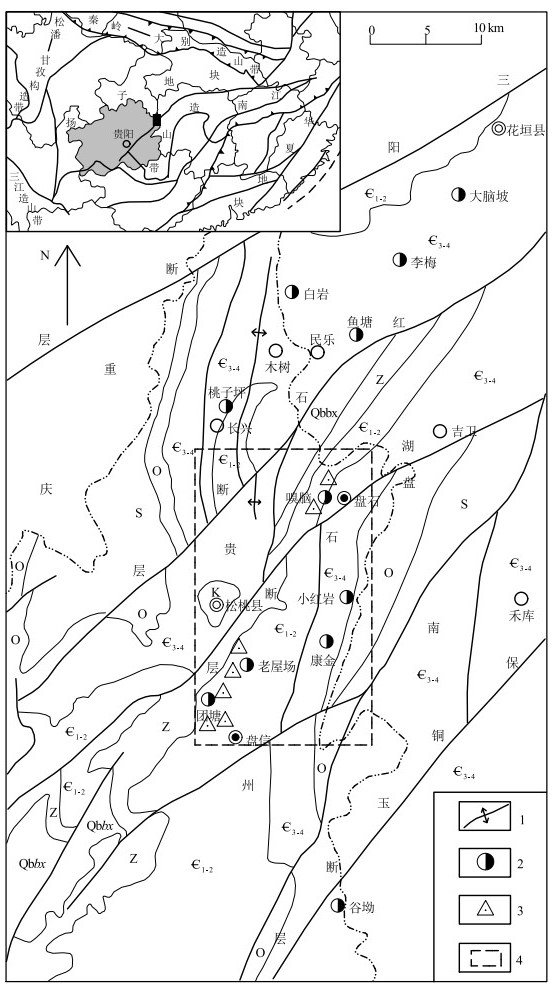
 下载:
下载:
